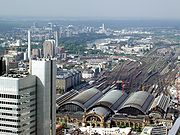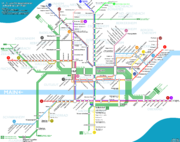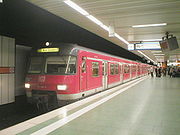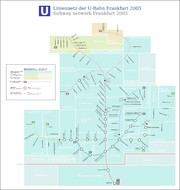
Public transport in Frankfurt am Main
Encyclopedia


Ticket (admission)
A ticket is a voucher that indicates that one has paid for admission to an event or establishment such as a theatre, movie theater, amusement park, zoo, museum, concert, or other attraction, or permission to travel on a vehicle such as an airliner, train, bus, or boat, typically because one has...
is valid for a journey which may include several modes of transit run by different operators.
The fares are paid in advance of travel at a ticket vending machine or on board a bus
Bus
A bus is a road vehicle designed to carry passengers. Buses can have a capacity as high as 300 passengers. The most common type of bus is the single-decker bus, with larger loads carried by double-decker buses and articulated buses, and smaller loads carried by midibuses and minibuses; coaches are...
. There are no turnstile
Turnstile
A turnstile, also called a baffle gate, is a form of gate which allows one person to pass at a time. It can also be made so as to enforce one-way traffic of people, and in addition, it can restrict passage only to people who insert a coin, a ticket, a pass, or similar...
s or other controlling barriers - passengers therefore have responsibility
Proof-of-payment
Proof-of-payment or POP is an honor-based fare collection approach used on many public transportation systems. Instead of checking each passenger as they enter a fare control zone, proof-of-payment requires that each passenger carry a ticket or pass proving that they have paid the fare. Ticket...
for ensuring they have a ticket. Plain-clothes ticket inspectors are employed and carry out checks to ensure passengers have paid. If found to be travelling without a ticket, then they are required to pay an increased fare of €
Euro
The euro is the official currency of the eurozone: 17 of the 27 member states of the European Union. It is also the currency used by the Institutions of the European Union. The eurozone consists of Austria, Belgium, Cyprus, Estonia, Finland, France, Germany, Greece, Ireland, Italy, Luxembourg,...
40.
A trip within Frankfurt costs between €1.50 and €2.40, and a journey to the suburbs outside Frankfurt costs between €3.60 and €6.75 approx.
Rapid Transit

The suburban rail service is provided by rapid transit trains (S-Bahn
S-Bahn
S-Bahn refers to an often combined city center and suburban railway system metro in Austria, Germany, Switzerland and Denmark...
). All but one of the lines run together in a single underground section through the city centre, and then go their separate ways at either end. In the suburban sections they are generally double-tracked or share mainline tracks with other regional, long distance passenger and cargo trains.
The trains can be up to 200 m (600 ft) long and have a maximum speed of approximately 140 km/h (90 mph). Electricity supply is provided by overhead wires
Overhead lines
Overhead lines or overhead wires are used to transmit electrical energy to trams, trolleybuses or trains at a distance from the energy supply point...
at the common German
Germany
Germany , officially the Federal Republic of Germany , is a federal parliamentary republic in Europe. The country consists of 16 states while the capital and largest city is Berlin. Germany covers an area of 357,021 km2 and has a largely temperate seasonal climate...
railroad voltage (15,000 volt
Volt
The volt is the SI derived unit for electric potential, electric potential difference, and electromotive force. The volt is named in honor of the Italian physicist Alessandro Volta , who invented the voltaic pile, possibly the first chemical battery.- Definition :A single volt is defined as the...
s AC
Alternating current
In alternating current the movement of electric charge periodically reverses direction. In direct current , the flow of electric charge is only in one direction....
).
The normal service interval on each of the lines is 15 or 30 min, but on the central sections a train runs approximately every 2 minutes during rush hour
Rush hour
A rush hour or peak hour is a part of the day during which traffic congestion on roads and crowding on public transport is at its highest. Normally, this happens twice a day—once in the morning and once in the evening, the times during when the most people commute...
.
Frankfurt's rapid transit is very popular because it is fast. It has the added benefit of being very cost-effective for medium-distance lines with high usage.
Trams
There are 9 Tram lines, with trams arriving usually every 10 min. Many sections are served by 2 lines, combining to give a 5 minute frequency during rush-hour.
Underground

Stadtbahn
A ' is a tramway or light railway that includes segments built to rapid transit standards, usually as part of a process of conversion to a metro railway, mainly by the building of tunnels in the central city area....
lines known as the U-Bahn
Frankfurt U-Bahn
The Frankfurt U-Bahn, together with the Frankfurt S-Bahn and the Frankfurt Straßenbahn, is the backbone of the public transport system of Frankfurt, Germany. Its name derives from the German term for underground, Untergrundbahn. The U-Bahn opened in 1968 and now consists of 87 stations on nine...
.
- The U1-U3 run from the southern railway station to the north of the city on a common route. They then split and serve Nordweststadt (U1) the town of Bad Homburg-Gonzenheim (U2) and the town of OberurselOberurselOberursel is a town in Germany. It is located to the north west of Frankfurt, and is the second largest town in the county of Hochtaunuskreis and the 14th largest town in Hessen.-Extent of municipal area:...
(U3) - The U4 runs from Bockenheimer Warte, through the fair, the main train station, the city centre to Bornheim (Frankfurt am Main)Bornheim (Frankfurt am Main)Bornheim is a district or Stadtteil of Frankfurt am Main, Germany, with approximately 25,861 inhabitants. It is part of the Ortsbezirk Innenstadt IV, and is subdivided into 5 Stadtbezirke....
Seckbacher Landstraße. Since June 2008 every 2nd or 3rd train continues to Schäfflestraße with connection to the U7. This route has been the only line which runs entirely underground, except from the part behind Seckbacher Landstraße. - The U5 is a combined tram and underground line heading from Preungesheim to the city centre. There it co-shares four underground stations with the U4.
- The U6 runs from Heerstraße in the west, to Ostbahnhof (East Station) in the east.
- The U7 runs from Hausen in the west, to Bergen-Enkheim in the north-east.
- The U8 and U9 serve a new connecting section between the U1 and U2 northern ends. U8 goes from Riedberg in the new section of track to Frankfurt-Süd sharing the tracks with U1-3. U9 starts from the north at Nieder-Eschbach on the (shared) U2 line and goes along the new track that it shares with U8, then along a short section of U3, and finally connecting to the U1 tracks to Ginnheim in Nordweststadt.

The minimum service interval is 2.5 minutes, although the usual pattern is that each line runs with a 7.5-10 minute frequency which combines to approx 3-5 minutes on the city centre sections served by more than one line.
The trains can be as long as 300 ft (100 m) and have a maximum speed of approximately 50 miles per hour (80 km/h). Cars are equipped with indicators and rear view mirrors and are powered from overhead wires.
There are several extension projects planned for the future, especially proposals to establish a full-fledged underground system. As this would be rather expensive, it will probably not be built in the near future, if at all. Even so history shows that Frankfurt's underground network has always grown slower than was planned.
Bus
Buses play a minor role in Frankfurt transit since all major routes are served by rail based modes of transportation. There are, however, several cross-town bus routes, especially in the north. Buses are also used as feeder services for the underground lines and operate.Organisational structure
- Rapid transit is run by Deutsche BahnDeutsche BahnDeutsche Bahn AG is the German national railway company, a private joint stock company . Headquartered in Berlin, it came into existence in 1994 as the successor to the former state railways of Germany, the Deutsche Bundesbahn of West Germany and the Deutsche Reichsbahn of East Germany...
, the national German railroad operator. - Light rail and trams are run by the city owned Frankfurt Transit Company (Verkehrsgesellschaft Frankfurt).
- Buses are run by Verkehrsgesellschaft Frankfurt, In Der City Bus, MainMobil Frankfurt, Alpina and Regionalverkehr Kurhessen.
- The city's transit planning unit is traffiQ.
- The fare structure and distribution between the operators is organised by the Rhein-Main-Verkehrsverbund.
Franchises
There are currently proposals for a shake-up of the way bus services are run. Instead of being operated by Frankfurt Transit Company, the routes could be split into different franchiseExclusive right
In Anglo-Saxon law, an exclusive right is a de facto, non-tangible prerogative existing in law to perform an action or acquire a benefit and to permit or deny others the right to perform the same action or to acquire the same benefit. A "prerogative" is in effect an exclusive right...
s for which any European bus operator may tender to run. The organisation offering the cheapest proposal would then be given a contract to run that route for several years.
See also
- Rhein-Main-VerkehrsverbundRhein-Main-VerkehrsverbundThe Rhein-Main-Verkehrsverbund is an organised transport network in the German state of Hesse, centred around the city of Frankfurt am Main. Its head office is located in Hofheim im Taunus...
- Rhine-Main S-BahnRhine-Main S-BahnThe Rhine-Main S-Bahn system is an integrated rapid transit and commuter transport system for the Frankfurt/Rhine-Main region, which includes the cities Frankfurt am Main, Wiesbaden, Mainz, Offenbach am Main, Hanau and Darmstadt...
- Frankfurt U-BahnFrankfurt U-BahnThe Frankfurt U-Bahn, together with the Frankfurt S-Bahn and the Frankfurt Straßenbahn, is the backbone of the public transport system of Frankfurt, Germany. Its name derives from the German term for underground, Untergrundbahn. The U-Bahn opened in 1968 and now consists of 87 stations on nine...
- Trams in Frankfurt am Main

